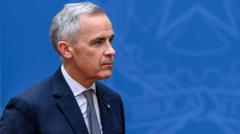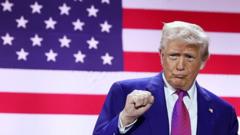With the announcement of "Liberation Day" tariffs approaching, uncertainty looms over their potential rates, the countries they will impact, and the economic effects on American consumers and businesses. Analysts are left speculating as the Trump administration prepares to finalize its plan.
The Impending Uncertainty of Trump's 'Liberation Day' Tariffs

The Impending Uncertainty of Trump's 'Liberation Day' Tariffs
President Trump is set to unveil a new series of tariffs that raise questions about rates, affected countries, and the broader economic implications.
As the countdown begins for President Donald Trump's highly anticipated announcement of "Liberation Day" tariffs, uncertainty engulfs the economic landscape. Since taking office, Trump has continuously rolled out tariffs, most recently affecting Chinese imports and metals from Canada and Mexico. With new duties on cars due shortly, all eyes are on specifics of the overarching tariffs that have been in the works by his administration.
One critical element of this discourse is the magnitude of the tariffs. While the White House remains mum on definitive figures, past statements from Trump suggest a range that could start from a 10% across-the-board tariff on imports, advancing towards 20% or even 60% targeted at China. Discussions of “reciprocal” tariffs add complexity, as the administration signals potential variations by country, but these only heighten the confusion among businesses and political entities trying to gauge their future liabilities.
Equally fuzzy is the issue of which countries will be included in the tariffs. Trump indicated a sweeping plan that may affect "all countries," crushing hopes among nations like the UK that sought to evade higher taxes. The administration’s prior identification of a "Dirty 15" — nations deemed to have unfair tariffs against U.S. businesses — leaves open the question of whether upcoming duties will target specific nations or be more general.
The consequential implications of such tariffs on the U.S. economy bring significant concern. While technically defined as taxes on imports, the economic reality dictates that U.S. firms facing these taxes will either absorb them or pass them on to consumers, influencing market prices. Early anecdotes from businesses indicate an inclination to offset costs, potentially leading to increased prices for Americans and concerns of reducing consumer demand.
Further complicating matters are the potential retaliatory measures from other nations and the intricate balancing act between navigating domestic manufacturing costs and foreign tariffs. As Trump prepares to reshape the U.S. trade framework, the immediate aftermath of Wednesday’s announcement promises to hold unpredictable consequences, not only domestically but also across the global marketplace.






















